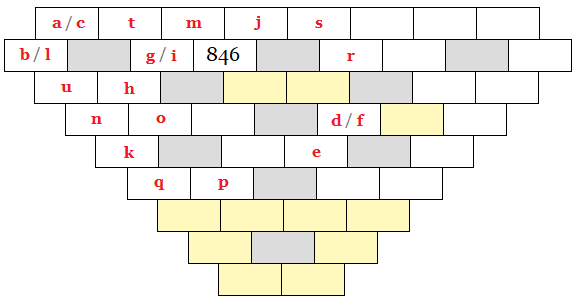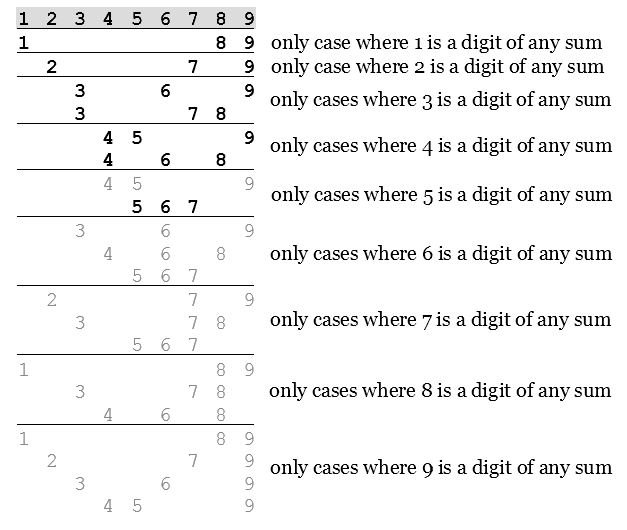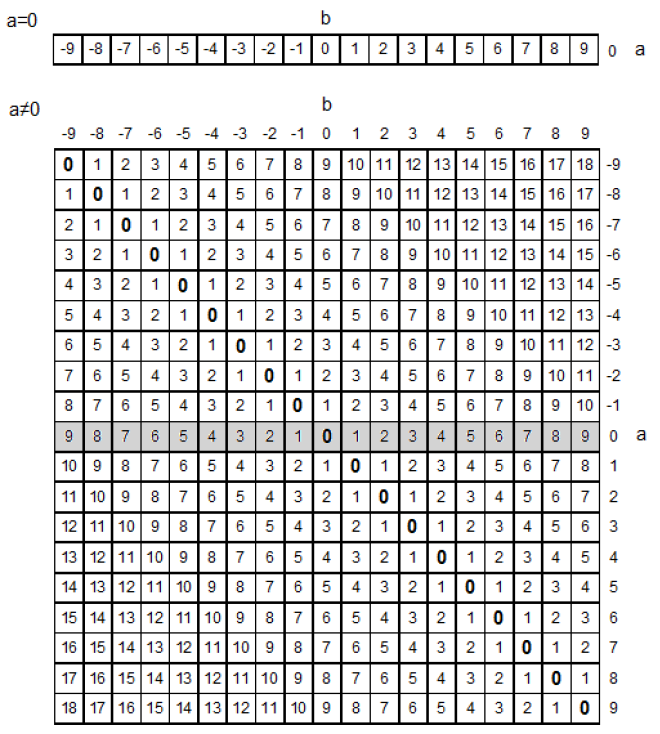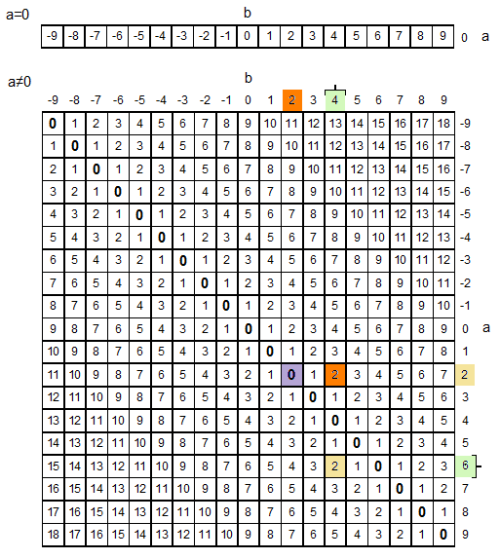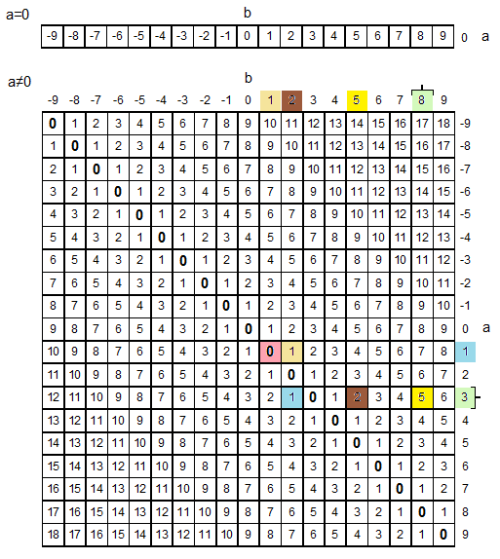This is a long post. Take your time exploring it.
Last post we walked through a scheme to solve a math challenge posed by Dennis Coble, a fellow tweeter and friend of mine.
This challenge, which I dubbed All-digits Arithmetic, follows.
Here’s 1 that might interest you. Numbers 1-9 all used: 3 digit number, plus or minus 3 digit number, gives another 3 digit number.
Before moving further, I invite you to attempt to solve this challenge. I guarantee if you try it, it will engage you and get you thinking mathematically.
Spoiler alert: Reading further will spoil the fun and learning that attempting the challenge will provide. Try it before you read on.
Did you find all 336 answers to the challenge?
Congratulations if you did.
Today we are going to search for relationships between the 21 distinct answers to the challenge.
Before we do that though, we need to standardize what we define as a distinct answer.
Defining a standard distinct answer
For each answer there are 16 variants.

These form a distinct family of answers — every variant is a sibling. So, there are 21 families with 16 siblings each.
For the moment, let’s label the siblings in the first row above 1 through 8 from left to right and repeat this labelling, using 9 through 16, in the second.
Now, we have all 336 answers and we want to intelligently talk about them, compare them and maybe even convert them into each other. So we pick variant 3 from family 12 and variant 7 from family 1 and compare them. We do the same to variant 14 from family 18 and variant 9 from family 20. (We can continue this way until all 336 answers are paired and compared.)
The problem we face, even if we find patterns, is that we cannot generalize from this hodgepodge of comparisons. The comparisons may not translate across all 21 families.
In order to intelligently communicate, compare and possibly convert the answers in a replicable way, we need to compare, say, variant 8 across all families. This means we need to decide on a standardized representative for each family.
This standardized representative will be the distinct answer and its siblings will be its variants.
You can pick any variant — variant 8 above, for instance — to be your standardized representative across families.
Defining distinct answers
Two parameters define each answer: the relative value of each digit in the same place-value position in the two addends and where the free column is.
This is my representative across the families. Again you can define yours as you like. Doing so might reveal different relationships between the families than I will describe here. This is why students should be set free to define their own representatives.

In my definition, the free column is in the hundreds place and each digit in the top addend is less than the digit below it in the bottom addend. There is nothing special about this definition; it is just what I chose so I can define what I am describing and comparing.
With this definition — with a definition — you are now able to understand what I am describing and replicate it if you wish. You can do the same with any other definition, so long as the definition is adhered to across families.
Okay, then. Enough of the terminology. You are here to learn how all these distinct answers relate.
But first another spoiler alert.
Stop: From this point I reveal the answers to the challenge. If you want to attempt the challenge, do not read further.
The distinct answers of Coble’s challenge
Here are my 21 distinct answers to Dennis Coble’s challenge.
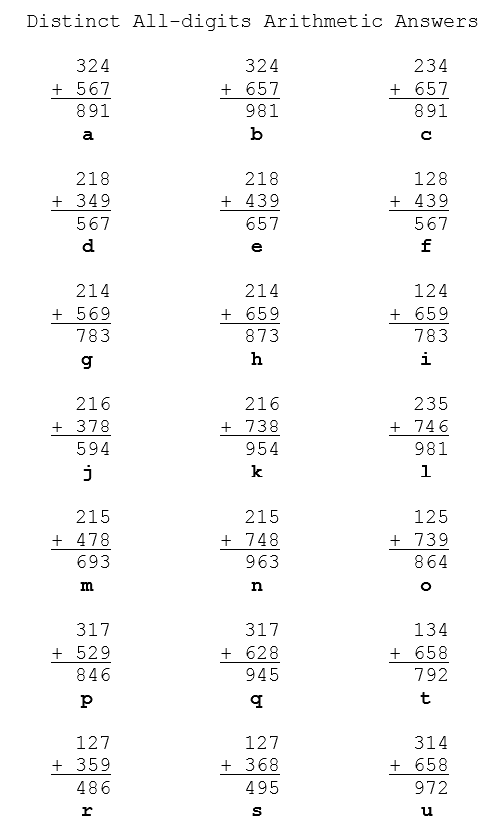
Sort of anticlimatic given all the build-up, isn’t it?
For me though, this is the springboard for the fun stuff. The answers are just the start of the math.
Notice the free column is in the hundreds place in all my answers and each digit in the top addends has a value less than the digit in the same place in the bottom addends.
Also, I ordered and labelled these answers this way in light of the discussion that follows.
Analyzing the distinct answers
Finding the answers is a huge accomplishment. It requires systematic analysis or extensive brute force. But if we ended there, the All-digits Arithmetic challenge would just be another math problem, fun, full of learning and mathematical thinking, but no more than another exercise.
I never like to throw away an opportunity to explore. I have the answers. Now I want to know how they are related — if they are related, because math plays in connections, patterns and disruptions of these.
So, let’s do some exploring.
Inquiry: Vertical exchange of digits
We already described the vertical exchange of digits when we defined the 16 variants or siblings of each distinct family. What we found, for each answer, were these variants.

Notice all the vertical exchanges involve the addends only.
Applied to a specific family — here family ‘ l ‘, this familiar analysis produces the following pattern of answers. (Repeating this application across all 21 families produces a 21 x 16 grid.)

Attempting to exchange digits vertically across the sums, however, changes the digital sum of these totals, which breaks the observation proven last post that the digital sum of the total for each answer must be 18 for the answer to be correct.

A similar problem occurs when digits in the top addend and the sum are exchanged vertically. Notice above which answers don’t work and why.
Similarly, if you have been following along and you chose to explore subtraction instead of addition, any vertical exchanges that change the minuend break the answer and are not viable.
Math Lab 6 Question 4
With this inquiry and the standardization of the distinct answers, we resolve question 4 in the All-digits Arithmetic math lab.
- Group all answers that can be converted into a distinct answer with that distinct answer. What manipulations of these answers will standardize the format of distinct answers?
Turning one distinct answer into another
The following analyses will resolve the next one.
- What one-step manipulations will turn one distinct answer into another?
There are three types of transformation we can apply to our distinct answers to determine how they relate:
- digit exchange (vertical, described above; and horizontal, described below),
- digit rotation (90° CCW, 180° and 270° CCW), and
- digit flip (across the positive or primary diagonal and across the negative or secondary one).
To simplify the analyses, we will convert each distinct answer into a 3×3 grid in place of the addition or subtraction it now is.

Inquiry: Horizontal exchange of digits
Let’s continue comparing distinct answers by horizontally exchanging digits.
We can exchange digits horizontally simultaneously across one row, two rows or three rows.

When only one column is involved, no horizontal exchange is possible. Moving digits from one column must displace digits from another, which contradicts the one-column restriction.
On the other hand, there are 21 potential two-column horizontal exchanges. For example, given the digits abc, the exchanges are ab → ba, ac → ca and bc → cb. This pattern holds for each of the three rows individually, paired or grouped with the two other rows.
Notice for the two-column exchanges involving two rows, those rows can be contiguous (the two addends or the bottom addend and the total) or split (the top addend and the total).
Also notice that the exchange of the full middle column (b-e-h) with either edge column maintains the order of the other two columns. The two results place the middle column (b-e-h) to the far left or the far right of the other two columns, emulating the placement of the no-lending-nor-borrowing (free) column in the hundreds place and the units place of the challenge additions.
For horizontal exchanges involving all three columns, all digits in an exchanging row must move; otherwise, we have a two-column horizontal exchange. In the table above, digits in the first column move into the second, those in the second column move into the third and those in the third column move into the first. This pattern holds for each row, each row pair and for the full column of three rows.
For the digits abc in one row, the results of the three-column horizontal exchange are abc → cab → bca (→ abc). The right most column slides to the far left, emulating the movement of a free column from the units place to the hundreds place. Notice the Latin Square nature of the results.
Once again, the rows can be contiguous or split.
Further, like the two-column exchanges, there are 21 potential three-column exchanges.
Try finding those horizontal exchanges that relate distinct answers and convert the answers into each other.
Results: Horizontal exchange of digits
Twelve distinct answers relate pairwise through single horizontal exchanges.
Let’s describe the relationship of the a, b, c set of distinct answers. These distinct answers are interlinked to each other as follows.
Distinct answer a can be converted into b by horizontally exchanging the four digits in the bottom left corner. That is, digits 5 and 8 in the bottom of the free (left) column and digits 6 and 9 in the bottom of the borrowing (middle) column exchange, turning distinct answer a into distinct answer b.
a can also be converted into c with a similar exchange in the top left corner. So, 3 and 5 exchange with 2 and 6.
Meanwhile, b can be converted into c by horizontally exchanging the top left two digits, 3 and 2, and the bottom left two digits, 9 and 8, simultaneously.
These exchanges can occur in reverse as well. b can convert into a by horizontally exchanging the four digits in the bottom left corner of b, so creating a. (For now, don’t worry about the orange portion below.)

Imagine that: three distinct families interrelated to each other by one-step horizontal exchanges. Take a look at those distinct answers and see that 324, 657 and 891 repeat, interlinking the distinct answers like a chain, while 234, 567 and 981 do not. Also, in the top left corner of distinct answers a and c, the digits vertically add to eight in the middle (2 + 6 in a and 3 + 5 in c) and left (3 + 5 in a and 2 + 6 in c) columns.
This same set of exchanges also converts, and relates, distinct answers d, e and f, and g, h and i.
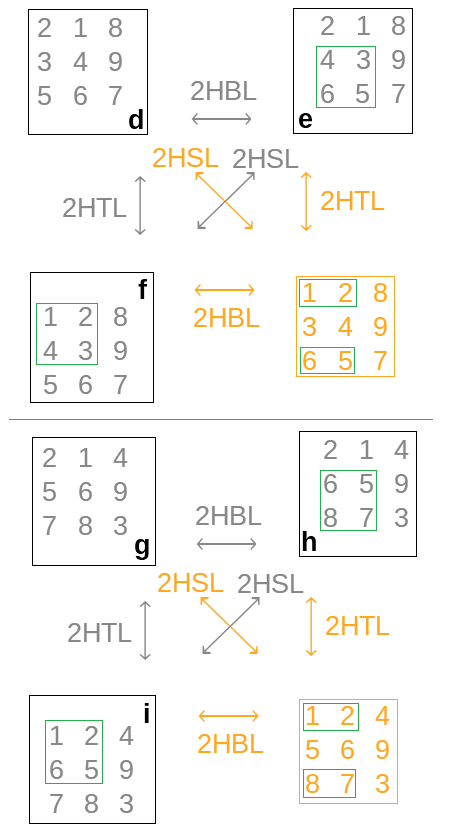
To simplify communication, I labelled the two-row horizontal exchange 2H; for one row, the horizontal exchange would be 1H, and for three rows, 3H. The top left corner is TL, the bottom left BL and the split left SL. (Right counterparts also exist. The group of four corner digits is labelled SS — split horizontally and vertically.)
The horizontal exchanges involving the nine distinct answers above follow this schema.

This schema illustrates that
- horizontally exchanging digits in the borrowing column and free column viably converts some distinct answers into others (the lending column is not involved),
- these exchanges are reversible (a converts to b iff b converts to a) and commutative (2HBL2HTL = 2HTL2HBL = 2HSL), and
- not all grids whose total or minuend rows have digital sums of 18 are answers nor even viable additions or subtractions (so the orange portion of the exchanges above).
Distinct answers j and k, and m and n, are similarly related except that horizontally exchanging the top left corners does not convert either distinct answer into viable additions nor answers. Because of this, neither 2HSL is viable either.

Why do j and k, and m and n not follow the same pattern as a, b and c, d, e and f, and g, h and i?
It is because the top left corner of each of j, k, m and n does not have digits that vertically add to the same total. For example, 2 + 4 = 6 in the left column of m, 1 + 7 = 8 in m‘s mid-column, 2 + 7 = 9 in n‘s left column and 1 + 4 = 5 in the mid-column of n.
The 2HTL exchange only works if the four digits being horizontally exchanged add vertically to the same sum. The schema that worked so well for the first nine horizontal exchanges above must be modified to account for this restriction.

With this modification, eleven of the twelve horizontal-exchange relationships can be explained by this schema.
Finally, t and u are related through a 2HSL exchange. Neither the 2HTL nor 2HBL exchanges in the modified schema produce viable additions here.

or

2HTL exchanges do not work for t and u for the same reason they do not work for j and k, and m and n.
I don’t know why the 2HBL exchanges do not convert t and u into viable additions, beyond the fact that the additions do not work. Perhaps this is an investigation you might pursue. Or a more fruitful pursuit may be to ask why 2HBL works for all the other conversions involving 2HBL.
u was the last distinct answer I found and I found it because of this exchange.
Inquiry: Rotation of digits
Well, that was rather informative. We found twelve related relationships between distinct answers and a new distinct answer. Let’s try another transformation: rotation of digits.
Since each answer is an orthogonal grid and remains so, we have three possible rotations to deal with. A 90° turn rotates digits 90° counterclockwise; the block of digits that rotates flops onto its left side. A 270° turn on the other hand rotates the digits 90° clockwise — a flop to the right. Finally, a 180° turn rotates them 180° — on the block’s head. This is actually my favourite rotation because it is equivalent to a flip across the positive diagonal of the block, then another across the negative diagonal, or a horizontal exchange of the block digits, then a vertical one.

The following rotations then are possible.
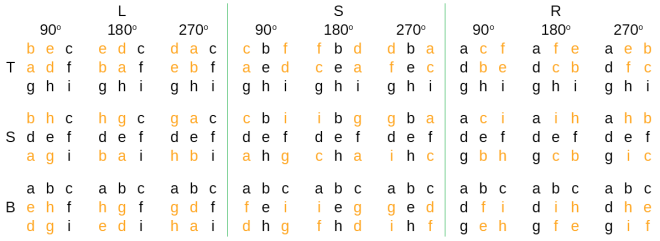
Before we continue, determine on your own what rotations relate distinct answers.
Results: Rotation of digits
Only the 180° rotations connect distinct answers in one step.
Distinct answers a, c; d, f; and g, i are related by a 2HTL exchange. They are also related by a 180TL rotation, after the rotation is standardized (a < d and b < e). (Why does this make sense?)

Notice that only the addends in the free and borrowing columns are involved in these rotations. These are also the digits that, in each pair of distinct answers, add vertically to the same sum.
Let’s try something else. Rotating d by 180BR produces j after standardization, while rotating it by 180BS produces n. These same rotations convert e into m and k respectively.

As illustrated in the diagram above, d and e, j and k, and m and n themselves are related by 2HBL exchanges: 3 and 5 switch with 4 and 6 (in d and e), 3 and 5 switch with 7 and 9 (in j and k), and 4 and 6 switch with 7 and 9 (in m and n). Note the chain-linking of these distinct answers reminiscent of similar linking of a, b and c; d, e and f; and g, h and i.
Obviously, j and m, and k and n are also related through these relationships.
Finally, p and q are related by a 180BS rotation, while r and s are related by a 180BR one, both sans standardization.

This makes nine one-step rotation conversions. But there’s more.
Aside: A special two-step conversion
The conversion of p into r and q into s is 90TL1HBL. From there a simple r, s conversion converts p into s and q into r. If you look closely p also converts into s and q also converts into r by starting with a p, q conversion, then applying 90TL1HBL.

The reverse conversion, turning r into p and s into q, is 1HBL270TL or 270TL1HBL. 90° clockwise is the reverse of 90° counterclockwise. Preceding that with a simple r, s conversion, or following it with a p, q conversion, converts r into q and s into p.
Notice only the free and borrowing columns are involved in the two-step conversion. The lending column is not, again.
Inquiry: Flipping of digits
The horizontal and vertical exchanges are really reflections across the vertical and horizontal axes. Flipping is a reflection across a diagonal, either the primary or positive one (F1) or the secondary or negative one (F2).

There are 18 potential flip transformations.

Try to find flip transformations that relate distinct answers.
Results: Flipping of digits
Did you figure it out? There are no one-step flips that convert one distinct answer into another.
But there are two-step ones.

j converts into m using F2SSF1BS; k into n uses F2SRF1BR. The reverse conversions, turning m into j and n into k, use the same formulae. The details parallel those of converting p and r, and q and s.
What about 3-Row and 3-Column transformations?
Except for the horizontal movement of the free column from the units place to the hundreds place and vice versa, and the vertical exchange of the addends, there are no viable 3-Row and 3-Column transformations that change one answer into another.
Summary: Relating Distinct Answers
Our analyses revealed 37 conversions connect answers in the All-digits Arithmetic challenge.
- Free = 2 — the free column (that neither lends nor borrows) can float between the hundreds place and the units place.
- V = 8 — the digits in the addends are vertically commutative; with two addends and three digits, that makes 8 vertical exchanges.
The above two parameters group answers into 21 distinct families with each answer being a sibling — Siblings = 16.
- H = 12 — (all 2H) two rows exchange digits horizontally in the following ways:
- a,b,c, d,e,f and g,h,i are related by 2HTL, 2HBL and 2HSL,
- j,k and m,n are related by 2HBL (2HTL does not work because the addend digits involved add vertically to different sums), and
- t,u is related by 2HSL.
- R = 9 — (all 180°) four digits rotate in the following ways:
- a,c, d,f and g,i are related by 180TL (this is related to the 2HTL exchange and the digits’ common vertical sums),
- p,q, d,n and e,k are related by 180BS, and
- r,s, d,j and e,m are related by 180BR.
- F = 0 — there are no one-step flips of digits that relate distinct answers.
- l and o = 0 relationships — these two distinct families do not relate to any others, including each other.
The 2HTL exchange and 180TL rotation of a,c, d,f and g,i illustrate that some distinct answers can be converted into each other in more than one way.
Most conversions involving more than one step are forced and non-generalizable at best. There are a few though that systematically convert distinct answers in relatable ways.
- p,r and q,s are related by 90TL1HBL, and open the way to relate p,s by 90TL1HBL180BR (pr,rs) or 180BS90TL1HBL (pq,qs) and q,r by 90TL1HBL180BR (qs,sr) or 180BS90TL1HBL (qp,pr). Notice these last four are the same two conversions, showing that conversions relate more than one pair of distinct answers, depending on the starting answer.
- j,m is related by F2SSF1BS, and opens the way to relate j,n by 180BR180BS (jd,dn), F2SSF1BS2HBL (jm,mn) and 2HBLF2SSF1BS (jk,kn). Again, there are just two conversions here (transformations are commutative).
- k,n is related by F2SRF1BR, and opens the way to relate k,m by 180BS180BR (ke,em), F2SRF1BR2HBL (kn,nm) and 2HBLF2SRF1BR (kj,jm). Notice the parallel to the conversions of j,m and j,n.
Pattern: Relationships between transformations
180° and 2H are related, after addend standardization (a < d, b < e and c < f), except when the total (bottom) or minuend (top) is involved. So are 90° and F2, and 270° and F1 under the same conditions.
Compare the shaded grids below. We are using distinct answer a as an example.
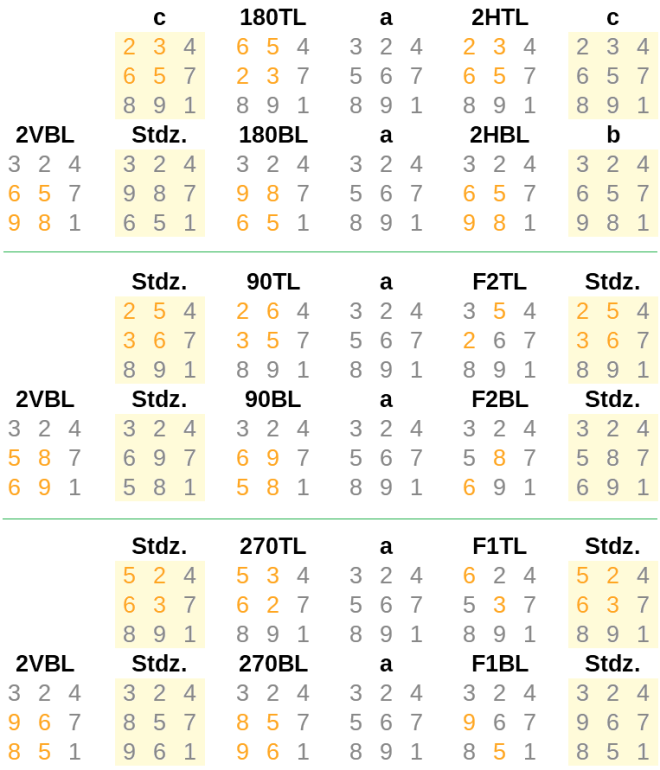
Notice that adding 2VBL — vertically exchanging digits in the bottom rows of the free and borrowing columns — resolves the discrepency between the shaded grids when the total is involved in the conversion. (Why does this work?)
Notice also that most of these grids are not correct additions. Here we are treating the digits as entries in grids, not as digits in numbers.
To see this point for yourself, try the above conversions with distinct answer o: 125 + 739 = 864. We know for o none of the additions will be correct (they would relate o to other distinct answers otherwise), so we can concentrate on the grid of digits.
Pattern: Families, clans, sets, petals and kin
One thing that the above analyses have shown us is that the answers to Coble’s challenge are related at several scales.
Following is a summary of these scales.
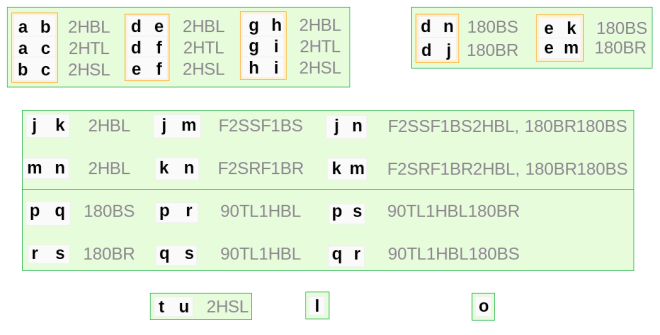
- 21 families — Each bold letter corresponds to a distinct answer, which represents a family of 16 siblings.
- 20 clans — Each grey box corresponds to a relationship or conversion. The pair of letters in this box form a clan, two families linked by a direct (one-step) connection. The two- and three-step conversions are extensions and not separate clans. l and o are placed in (pseudo-)clans containing only one family.
- 5 sets, or camps — When these clans are connected by interlinked distinct answers and conversions, they form a set (orange).
- 7 kin — Clans with similar conversions are grouped into a box of kin (green).
- Kin with parallel conversions are stacked on each other; they share a common border.
- 14 petals — Stacked and lone clans also form petals. These are the grouping of clans as described in this post: a,b,c; d,e,f; g,h,i; j,k; m,n; t,u; p,q; d,n; e,k; r,s; d,j; e,m; l; and o. They will be summarized in the following section.
This analysis resolves the last question in the All-digits Arithmetic math lab.
- Group distinct answers, that can turn into each other in one step, into clans. How many clans are there? Are these one-step manipulations unique in each clan?
Pattern: All-digits Arithmetic flower
The distinct answers are arranged here in petals, nations and stabiles. Click on the flower to enlarge it.
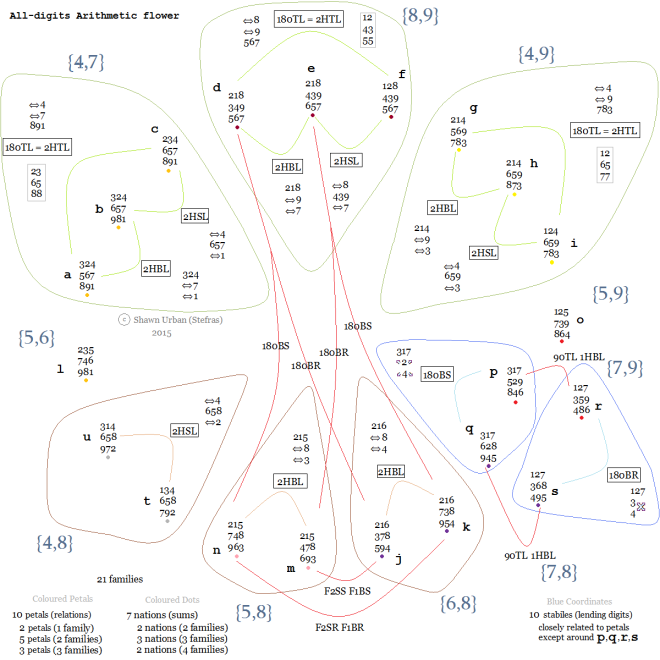
Notice the three sets a,b,c; d,e,f and g,h,i form three radiating petals as do j,k; m,n and t,u. p,q and r,s, meanwhile, form two “tangential” petals. And finally l and o form a petal each (not drawn). d,j; d,n; e,k and e,m do not form petals as such, but their conversions are drawn through the centre of the flower. These petals reflect relationships between the distinct families.
The petals are ordered so those distinct answers with the same digits in their totals are grouped into nations. So, a, b, c and l with digits 1,8,9 in their totals are grouped together. d, e and f have digits 5,6,7. g, h and i have 3,7,8. o, p and r have 4,6,8. j, k, q and s have 4,5,9. m and n 3,6,9. And t and u 2,7,9.
The stabiles are nearly identical in arrangement to the petals, except that p and r, and q and s are grouped together instead of p and q, and r and s. This is why the petals formed from these four families are tangential rather than radial. Stabiles reflect the immutable addend digits in the lending column. {4,7}, for instance, are the addend digits in the lending columns of a, b and c.
Joe Lubich, who you will hear more about next post, is responsible for the nation and stabile groupings.
Next post
Next post we will explore some extensions to the three-digit three-number All-digits Arithmetic challenge.
Did you like these analyses? Did you discover some new math? Please, comment and ask questions below. I look forward to seeing what you have to ask and say.






